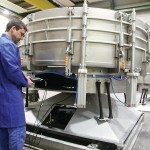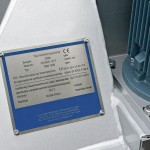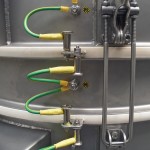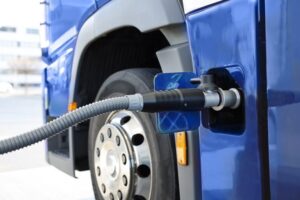Equipment containing potential ignition sources may only be installed in hazardous areas if it is certified for use in the relevant explosion risk zone. Particularly in the case of zone 0 and zone 20, an individual machine certification or a type examination certificate for the machine concerned must have been obtained from a European Notified Body. Various special rules must be observed in connection with screening machines.
Arthur Pilot
The first and, for the operator, most easily determined zone is that connected to the installation location. Depending on how frequently a potentially explosive atmosphere can occur, the installation location is defined as zone 1 or zone 2 in the case of flammable gases or as zone 21 or zone 22 if flammable dusts are involved. For example, if a dust explosion risk only occurs infrequently, the installation area may be classified as zone 22. The installation of screening machines in zone 0 or zone 20, i.e. in areas where a potentially explosive atmosphere is present permanently, for long periods or frequently, is not usual and is generally not permissible. There are also situations where the space surrounding the installation is not defined as an explosion risk zone, as the installation is satisfactorily dust-proofed and any occasional leakage of dust is extracted immediately. In some instances, only the space within a given radius of a potential dust emission point is considered to be a hazardous area. The plant operator is responsible in accordance with the EU directive 1999/92/EC and factory safety regulations for establishing which zones are applicable both inside the machine and in the area surrounding it.
The second important zone relates to the screening machine’s interior. Here, the product stream is broken up and the dust component distributed within the machine according to the product and screening specifications. A potentially explosive dust/air mixture can generally only occur if the dust particle size is <0.5 mm and the dust is present in the atmosphere in a sufficient concentration. If the flammable material to be screened is sufficiently fine and therefore poses an explosion risk, the space containing it should be designated as zone 20. Even when coarse material is screened, the formation of a potentially explosive atmosphere must be reckoned with if a sufficiently fine component of a flammable feed material is present in a sufficient quantity and fine mesh screen decks are used. In this case, the interior of the machine should be classified as zone 20.
With wet screening, the granular feed material is suspended in liquid. If the liquid used is flammable and has an ignition point below or within the screening temperature range, the interior of the machine comes under the definition of zone 0.
In some instances, the screening machine is installed in a gas hazardous area (e.g. zone 1) and the machine’s interior is defined as a dust hazardous area (e.g. zone 20). In such cases, the machine must be constructed so that seepage from the outside to the inside (or vice versa) is not possible and the formation of a hybrid mixture either inside or outside the machine is avoided.
It is possible to reduce the zone classification inside the machine by injecting an inert gas. Depending on the machine’s design and the monitoring of the residual oxygen content, the interior of the machine can be declared as zone 21 or 1, zone 22 or 2 or zone-free. However, this involves considerable expense, which is only rarely justified.
Ignition sources excluded
Allgaier screening machines are built such that all potential ignition sources as defined by DIN EN 1127-1 cannot occur or cannot create a risk of explosion. All possible electrical and non-electrical ignition sources are tested and assessed, for instance:
- Mechanically generated sparks and hot surfaces that occur due to the use of mesh cleaning aids with peripheral speeds >1 m/s.
- Mechanically generated sparks and hot surfaces caused by rotating weights with peripheral speeds >1 m/s outside the product space.
- V-belt drives in gas hazardous areas.
- Electrostatic charges caused by friction between moving parts of the machine or within the material being screened.
- Hot surfaces resulting from hot bearings, drive motors or friction.
- Ultrasound resulting from the use of ultrasonic mesh cleaning equipment.
- Insulated components that could accumulate an electrostatic charge, e.g. insulated metal parts of synthetic screen decks.
The Atex Directive 94/9/EC applies if a potentially explosive atmosphere can develop either inside or outside the machine and if the machine itself contains potential ignition sources of its own. The requirements that must be met in the individual zones are reflected in the subdivision of each zone into three categories for equipment operating in atmosphere with a potentially explosive dust (D) or gas (G) content. Particularly in category 1, risks that only rarely occur must be tested and assessed. The simultaneous occurrence of two risks must likewise not lead to an explosion.
The Directive also specifies the requisite competencies and conformity assessment techniques that are applicable when the equipment is put into service, depending on the category to which the screening machine (non-electrical equipment) will later be allocated:
- A screening machine in category 1 (zone 0, zone 20) must be assessed and tested by a European Notified Body.
- In case of screening machines in category 2 (zone 1, zone 21), all relevant documentation – and in particular the manufacturing documentation and that relating to the risk assessment carried out by a European Notified Body – must be submitted.
- With category 3 (zone 2, zone 22), it is sufficient for the relevant documentation to be available from the manufacturer.
Alternatively, each individual machine may be tested and assessed by a European Notified Body. Machines in category 1D may be installed in all three dust explosion risk zones (20, 21 or 22).
To allow plant operators to respond as flexibly as possible, Allgaier Process Technology has had production model tests and assessments carried out in accordance with the EU directive 94/9/EC. Suitable prototype machines have been built and assessed by a European Notified Body in accordance with currently applicable standards. The technical documentation submitted has been evaluated in parallel. When an EU type examination certificate is issued, it must be established that the named machine or machines have been manufactured in line with the approved documentation and the test report. Allgaier therefore implements the necessary quality assurance procedures as approved by a European Notified Body as per Appendix IV of the EU directive 94/9/EC. These procedures ensure that the plant operator receives a safe, tested product that will not result in any explosion risk providing it is used correctly and in accordance with its intended purpose.
Machine labelling
The exact registration number in accordance with the EU directive 94/9/EC, and in case of apparatus in category 1 also the identification number of the Notified Body, must be shown on the machine’s nameplate. The transfer of an EU type examination certificate from one tested and approved machine to another machine type assembled by the same manufacturer is not allowed. Similarly, the installation in a hazardous area of replicas of the certified machine made by another manufacturer is prohibited.
Machines in category 1 must always have an EU type examination certificate. If no quality system is in force, each machine must additionally be inspected by a Notified Body (product examination in accordance with Appendix V of the EU directive 94/9/EC). The only permitted alternative is a full individual examination procedure (individual inspection in accordance with Annex IX of the EU directive 94/9/EC). In category 1, the machine’s nameplate must always indicate the identification number of the Notified Body that carried out the evaluation of the quality assurance system, the product evaluation or the individual machine examination. If details of the Notified Body are not given on the nameplate for a machine in category 1, or if only the category (e.g. 1D) is specified, it is likely that the machine has not been approved. Identification with just the letter “D” and no category is likewise not allowed, as this is the identification for a protection system.
If a Notified Body is specified in the machine documentation or on the nameplate, a simple Internet search will confirm whether this organisation is actually autho-rised to carry out evaluations of a given type of, for instance, non-electrical equipment.
All round screening machines of all sizes as well as all rectangular screening machines in Allgaier Process Technology’s ARSM series are available in accordance with equipment category 1D/2GD (zone 20 inside, zone 21/1 outside). Over and above these models, some machine types can also be supplied in category 1/2G (zone 0 inside, zone 1 outside) for wet screening. Complex screening tasks like processing dry materials with a solvent content are additionally possible. Thanks to the close cooperation with Notified Bodies, even the most challenging requirements can be met.
Hall 7, Booth 326
Online-Info www.cpp-net.com/2110402
Share:









